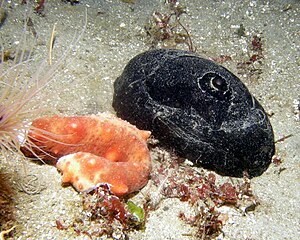Great California keyhole limpet
| Great California keyhole limpet | ||||||||||
|---|---|---|---|---|---|---|---|---|---|---|

A large California keyhole limpet (right) with a sea cucumber |
||||||||||
| Systematics | ||||||||||
|
||||||||||
| Scientific name | ||||||||||
| Megathura crenulata | ||||||||||
| GB Sowerby I , 1825 |
The Great California Keyhole Limpet ( lat. Megathura crenulata , English Great Keyhole Limpet ) is a sea snail from the family of slugs (Fissurellidae).
Habitat, distribution and description
The distribution area of the large California keyhole limbs extends from the coasts of southern California ( Monterey Bay ) to Mexico. There they live in the surf zones in water depths of up to 40 m, preferably in the lower tidal zone between 3 and 12 m depth on rocky ground.
The nocturnal snail eats tunicates and algae, which they eat from stones on which they are sucked with their feet. The snail can reach a length of up to 130 mm, making it the largest snail in the family of keyhole limbs. The “keyhole” that is present in the entire family and gives it its name is located in the center of the flat back plate. It is an opening in the body that the snail uses to breathe and act as a digestive tract, as well as house the genital tracts (pallial gonoduct). A special feature of the large California keyhole limpet is its coat that almost completely covers the back shield. The coat has light gray to black, sometimes brown, stripes.
Slotted snail hemocyanin
- → see main article slotted snail hemocyanin
The high molecular oxygen transport protein hemocyanin , based on a copper complex, is obtained from the hemolymph of Megathura crenulata . This slug-snail hemocyanin (KLH) leads to a strong immune stimulant in mammals and is approved in some countries as a medicinal substance for the treatment of superficial bladder carcinomas under the international non- proprietary name of immunocyanin .
Individual evidence
- ↑ K. Büchler: Structural, enzyme-kinetic and thermodynamic investigations at the KLH, the hemocyanin of the keyhole limpet Megathura crenulata. Dissertation, University of Mainz, 2008
- ↑ J. Schütz: Isolation, sequencing and investigation of physico-chemical properties of structural subunits and functional units of various arthropod and mollusc hemocyanins. Dissertation, Eberhard-Karls-Universität Tübingen, 2000
- ↑ C. Huber et al. (Editor) cancer immunotherapies. Deutscher Ärzteverlag, 2007, ISBN 3-769-11212-1 , p. 231.
literature
- KS Streit: Differential expression and molecular evolution of mollusc hemocyanin. Dissertation, University of Mainz, 2008
- G. Lindner: Mussels and snails of the world's oceans. BLV regulations book. BLV Verlag, Munich, 1975. ISBN 9783405154387
- J. Keep: West Coast Shells. Stanford University Press, ISBN 0-804-72109-2 , p. 146.
- JF Illingworth: The Anatomy of Lucapina crenulata Gray. , 1902, pp. 449-480.
- GR Murdock and S. Vogel: Hydrodynamic induction of water flow through a keyhole limpet (Gastropoda, Fissurellidae). In: Comp Biochem Physiol 61, 1978, pp. 227-231.
Web links
- Image of Megathura crenulata (Sowerby, 1825) (English)
- Various pictures of the shells of Megathura crenulata (English)
- Literature links on Megathura crenulata (English)
- The taxonomy of Megathura crenulata (English)